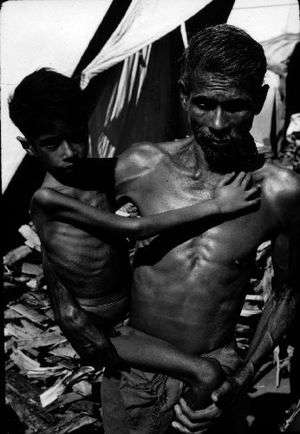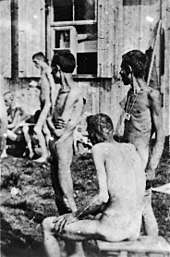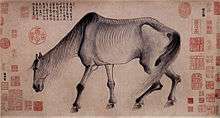Emaciation
Emaciation is defined as extreme weight loss and unnatural thinness due to a loss of subcutaneous fat (the fatty, or adipose tissue beneath the skin) and muscle throughout the body.[1] It affects human beings and animals; one who is emaciated could be described as "wasting away" or being "gaunt." Emaciation is caused by severe malnourishment and starvation. Emaciation is a predominant symptom of malnourishment, a basic component of poverty and famine that also occurs with diseases that interfere with the digestive system and appetite, other systems, and eating disorders.[2][3][4] These include nutrient deficiency disorders, diseases with prolonged fever and infection, malignant diseases, parasitic infections that can result from contamination, anorexia nervosa and other conditions. The malnourishment associated with emaciation has been referred to as "inanition", while infection by parasites has been described as "adulteration".[5] Treatment of emaciation includes gradual renourishment with a slow increase of daily caloric intake to help rebuild tissues and regain weight. Rest, and emotional and psychological therapy and support may be included.[6]
| Emaciation | |
|---|---|
 | |
| Photo from 1972 of an emaciated child in Nepal with marasmus | |
| Pronunciation |
|
Characteristics
In humans, the overall physical appearance of emaciation includes a thinning of the limbs, upper body and buttocks to an almost skeletal-seeming state with an apparent absence of fat and muscle tone. The skin is thin, dry and translucent in some areas of the body, to the point that veins beneath the skin are somewhat visible. The face is thin and drawn with a hopeless, vacant and distressed demeanor; the eye sockets are sunken, giving the eyes a bulging appearance. The scalp is bony with dry, withering hair that is lacking. On the torso, the collar bone, chest bone and ribs are quite pronounced; the stomach is bloated, which indicates gastrointestinal distress associated with nutritional depletion. The mouth and tongue may be excessively dry, or moist with the tongue thickly coated; there is usually strong halitosis, or foul breath.[3]
There is great fatigue, inability and lack of physical effort in the emaciated. Mental efficiency, problem solving and reasoning are somewhat impaired. The emotional state of an emaciated individual is often poor; feelings of depression, hopelessness, fear, anxiety and worthlessness may prevail. A person who is emaciated is usually submissive, both mentally and physically, to the will of others. Behavior is generally passive.[3][6]
The underlying starvation, malnourishment, and usually dehydration, associated with emaciation, affect and are harmful to organ systems throughout the body. The emaciated individual experiences disturbances of the blood, circulatory, and urinary systems; these include hyponatremia and/or hypokalemia (low sodium and/or potassium in the blood, respectively), anemia (low hemoglobin), improper function of lymph (immune system-related white blood matter) and the lymphatic system, and pleurisy (fluid in the pleural cavity surrounding the lungs) and edema (swelling in general) caused by poor or improper function of the kidneys to eliminate wastes from the blood.[3]
Cause


In most of Africa, poverty, malnutrition and disease are common. Among third world countries, India is one of the leading countries plagued by malnutrition, with more than 200 million people affected. Emaciation in India is referred to as "shosha roga", which means "exploitative disease".[4] Diseases such as these are nutrient deficiency disorders that can cause varying degrees of emaciation based on the type of nutrient(s) chronically and persistently lacking or absent from the diet of an individual.
Emaciation was also a major cause of death in Nazi concentration camps during World War II. It was largely the result of a starvation diet imposed on the inmates. It became endemic during the last stages of the war when rations were restricted even further.
It can also occur if a prisoner, often for a political cause or in plead of innocence, refuses food on a hunger strike or is forcibly fed but unable to retain the fluids or maintain nutrition.[7]
Restrictive diets can lead to significant weight loss, as can psychological problems, depression and social problems and issues. Anorexia nervosa is the psychological disease of a denial of weight loss and thinness while maintaining the same physical activity; Certain digestive diseases can induce weight loss. Diseases often associated with weight loss include tuberculosis, HIV infection, endocarditis or chronic inflammatory disease with febrile vasculitis, Behcet's disease,[8] connective, Still's disease,[9] sarcoidosis,[10] and certain cancers or blood diseases. Some neurological diseases such as Parkinson’s disease [11] may also cause significant weight loss. Poisoning such as chronic alcoholism,[12] drug addiction or taking drugs by mistake are also common causes. Taking too much medication is a possible cause of weight loss in the elderly and weak, if the medication suppresses appetite.
Famine and third world conditions are usually involved. Severe emaciation can be caused by marasmus, a disorder that is seen in children who are deprived of proteins, fats and carbohydrates. Both weight and growth are affected. A similar disorder, seen in very young malnourished children, is kwashiorkor. With emaciation mostly confined to the upper body, kwashiorkor often occurs after a child has been weaned and thus deprived of protein it was getting from its mother's milk. Slight emaciation is seen with nutrition disorders such as beriberi, caused by a lack of thiamine (vitamin B1), and pellagra, caused by insufficient intake of niacin (vitamin B3). The former is mainly characterized by mental impairment, and the latter is more serious, often leading to death.[4]
Other diseases and disorders associated with emaciation include malaria and cholera, tuberculosis and other infectious diseases with prolonged fever, parasitic infections, many forms of cancer and their treatments, lead poisoning, and eating disorders like anorexia nervosa.[3][4][6]
Treatment
Other than treating, curing or remedying the underlying cause of emaciation, it as a symptom is treated by regaining the weight and restoring the tissues. This is done through renourishment, or reintroducing nourishing liquids and foods to the body while increasing the intake of food energy. The process, usually begun in an individual deprived of food for a period of time, must be done slowly to avoid complications such as regurgitation and vomiting. It begins with spoonfuls of water and salted broth, advancing to increased amounts of clear liquids including broth, tea and fruit juices. This soon is advanced to full liquid diet such as milk (if no lactose intolerance is present) and cream-based soups. Once solid food is introduced, an emaciated individual is usually given up to eight small meals per day, at two-hour intervals. Meals may consist of a small milkshake to minor portions of meat with a starchy side item. For the purposes of weight gain and tissue rebuilding, the diet will be focused on proteins, fats and carbohydrates that are rich in vitamins and minerals, and relatively high in energy. Oily foods and high-fiber foods like grains and certain vegetables are discouraged because they are difficult to digest, and filling while lower in energy. Treatment of emaciation also includes much sleep, rest and relaxation, and counseling.[3][6]
Animals

The appearance and effects of emaciation in animals, both wild and domestic, is like that of humans–severe thinness, loss of fat and muscle, extremely pronounced and protruding bones, and weakness. Starvation and regularly dehydration, brought on by neglect and cruelty from humans, or as a result of illness are the usual causes of emaciation in domestic animals like dogs, cats and horses; in wild animals, starvation with emaciation is caused by unavailable sources of food, loss or changes of habitat, or neglect in captivity. The rehabilitation of emaciated animals, through treating their starvation and dehydration with slow renourishment, can be challenging. The unique and specific physiological and dietary needs of animals, be they mammals, birds, reptiles, carnivores, herbivores, etc. are carefully considered to avoid causing harm.[13][14]
See also
References
- "Emaciation". Medical-Dictionary.TheFreeDictionary.com. Retrieved January 19, 2012.
- Black's Medical Dictionary. A&C Black. 2009. ISBN 1-4081-4564-2. Retrieved January 19, 2012.
- Bose, Bholanoth. A new system of medicine, entitled recognizant medicine; or, The state of the sick. London: J. & A. Churchill. pp. 192–199. Retrieved January 19, 2012.
- "Shosha Roga (Emaciation)". Ayushveda.com. Retrieved January 19, 2012.
- Bose (1877, 2009), p. 194.
- Hoxie, George Howard (1910). Symptomatic and regional therapeutics. Appleton. p. 58. Retrieved January 19, 2012.
- Psychiatry in prisons : a comprehensive handbook. Wilson, Simon, 1970-, Cumming, Ian, 1962-. London: Jessica Kingsley. 2010. ISBN 9780857002068. OCLC 680017801.CS1 maint: others (link)
- "Behcet's disease - Mayo Clinic". mayoclinic.org. Retrieved 2015-07-15.
- "Emaciation Or Underweight". chestofbooks.com. Retrieved 2015-07-15.
- "Sarcoidosis - Mayo Clinic". mayoclinic.org. Retrieved 2015-07-15.
- "Parkinson's disease - Mayo Clinic". mayoclinic.org. Retrieved 2015-07-15.
- "chronic alcoholism". Retrieved 2015-07-15.
- "What is animal cruelty?". The British Columbia SPCA. Retrieved January 19, 2012.
- "Emaciation (Starvation) Protocol". Anapsid.org. Dec 2009. Retrieved January 19, 2012.
External links
| Classification |
|---|